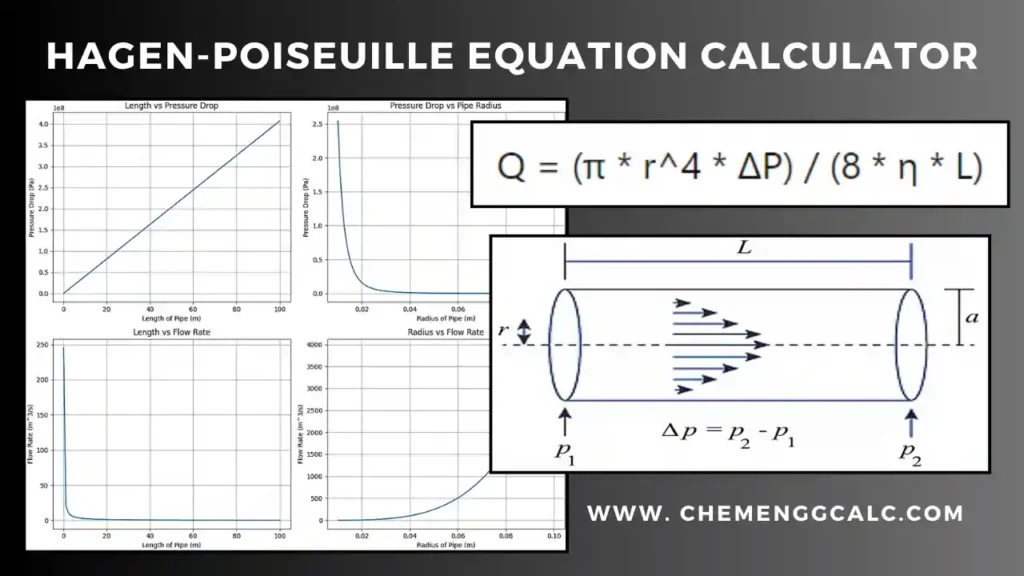Table of Contents
In mass transfer operations, Sherwood number is the dimensionless number which is used to know how efficiently mass is being transferred between a fluid (like gas or liquid) and a solid surface, or between different fluid phases.
This number is helpful in the design and analysis of equipment such as chemical reactors, distillation columns, absorption towers, and heat exchangers
Sherwood Number
The Sherwood number (Sh) is a dimensionless quantity named after Thomas Kilgore Sherwood. This number is used in mass transfer operations, representing the ratio of convective mass transfer to diffusive mass transport which plays an important role where mass transfer occurs between a fluid and a solid surface
Mathematically, it is defined as,
\[\text{Sh} = \frac{k_c L}{D}\]
Where in S.I units,
- kc is the convective mass transfer coefficient (m/s)
- L is the characteristic length (m)
- D is the diffusion coefficient m2/s
Note: In heat transfer Nusselt Number is analogous to Sherwood number in mass transfer.
Related: Fick’s Second Law of Diffusion – Concept and Calculation
Related: Hydraulic Diameter Calculator for Circular and Non-Circular cross-section
Sherwood Number Calculator
This Sherwood Number Calculator helps users to calculate key parameters related to mass transfer in fluid systems. Users can input the necessary values by choosing the parameter to select. This tool simplifies complex mass transfer calculations, making it accessible for engineers.
Related: Fick’s First Law of Diffusion Calculator – Molecular Diffusion
Related: Schmidt Number Calculator – Significance and Calculation
Significance of Sherwood Number
The Sherwood Number (Sh) is important in the study of mass transfer, it measures the relative importance of convective mass transfer compared to diffusive mass transfer.
- Low Sh Number (Sh < 1) means diffusion dominates over convection. For example in slow-moving or stagnant fluids where diffusion is the primary mode of transport.
- Sh Number around 1 (Sh ≈ 1) means that convective and diffusive mass transfer rates are comparable, such situation arises in moderate flow conditions.
- High Sh Number (Sh > 1) means that convection dominates over diffusion. This is more common in systems with fast-moving fluids, such as in high-speed mixing, turbulent flow, or forced convection systems where efficient mass transfer is crucial.
Boundary Layer Thickness – The thickness of the concentration boundary layer influences the Sherwood Number.
- A thinner boundary layer results in a higher mass transfer rate, leading to a higher Sherwood Number, as convection more effectively transports mass away from the surface.
Related: Nusselt Number Calculator – Significance and Calculation
Must Read: 10 Mostly used Dimensionless Numbers in Chemical Engineering
Sherwood Number Correlations
Sherwood Number can be correlated with other dimensionless numbers such as the Reynolds number (Re) and the Schmidt number (Sc) to characterize various mass transfer processes.
Here we have summarized Sh number correlations for flow over flat plate, within pipes and spheres under both laminar and turbulent regimes with their validity ranges based on Reynolds and Schmidt numbers.

These correlations are essential for designing and analyzing chemical reactors, separation processes, and other industrial systems where mass transfer is critical. By applying these correlations, engineers can estimate mass transfer rates and optimize process performance.
Related: Nusselt Number Calculator – Significance and Calculation
Other Dimensionless Numbers
Here we have tabulated the list of dimensionless numbers which are commonly used in Chemical Engineering with their formula, definition, and significance.
| Dimensionless Number | Formula | Definition | Significance |
|---|---|---|---|
| Reynolds Number (Re) | \[\text{Re} = \frac{\rho u L}{\mu} = \frac{u L}{\nu}\] | Ratio of inertial forces to viscous forces. | Determines flow regime: Re < 2000: Laminar flow Re > 4000: Turbulent flow. Critical for pipe flow and reactors. |
| Prandtl Number (Pr) | \[\text{Pr} = \frac{C_p \mu}{k}\] | Ratio of momentum diffusivity to thermal diffusivity. | It indicates the relative thickness of momentum and thermal boundary layers in heat transfer. |
| Nusselt Number (Nu) | \[\text{Nu} = \frac{h L}{k}\] | Ratio of convective to conductive heat transfer. | It is used in convective heat transfer problems to evaluate heat transfer coefficients. |
| Sherwood Number (Sh) | \[\text{Sh} = \frac{k_m L}{D}\] | Ratio of convective to diffusive mass transfer. | It is important in mass transfer, especially in diffusion and absorption processes. |
| Péclet Number (Pe) | \[\text{Pe} = \text{Re} \cdot \text{Pr}\] | Ratio of advection to diffusion. Combines Reynolds and Prandtl numbers. | It is important in heat and mass transfer processes where advection dominates over diffusion. |
| Schmidt Number (Sc) | \[\text{Sc} = \frac{\mu}{\rho D}\] | Ratio of momentum diffusivity to mass diffusivity. | It is used in mass transfer to relate momentum and mass transport. Analogous to the Prandtl number in heat transfer. |
| Lewis Number (Le) | \[\text{Le} = \frac{\alpha}{D} = \frac{\text{Sc}}{\text{Pr}}\] | Ratio of thermal diffusivity to mass diffusivity. | It relates thermal and mass transport; Le = 1 implies similar thermal and mass diffusivity. |
| Fourier Number (Fo) | \[\text{Fo} = \frac{\alpha t}{L^2}\] | Ratio of heat conduction rate to heat storage rate. | It is used in unsteady-state heat transfer problems, like transient conduction. |
| Biot Number (Bi) | \[\text{Bi} = \frac{h L}{k}\] | Ratio of internal thermal resistance to surface thermal resistance. | It determines whether heat conduction is lumped or distributed. Bi < 0.1: Lumped system approximation valid. |
| Weber Number (We) | \[\text{We} = \frac{\rho u^2 L}{\sigma}\] | Ratio of inertial forces to surface tension forces. | It is important in multiphase flows, droplet formation, and fluid interface stability. |
| Capillary Number (Ca) | \[\text{Ca} = \frac{\mu u}{\sigma}\] | Ratio of viscous forces to surface tension forces. | It is used to study the behavior of capillary flows and thin-film phenomena. |
| Froude Number (Fr) | \[\text{Fr} = \frac{u^2}{g L}\] | Ratio of inertial forces to gravitational forces. | It is important in free-surface flows, mixing, and fluidized bed design. |
| Damköhler Number (Da) | \[\text{Da} = \frac{\text{Reaction rate}}{\text{Flow rate}}\] | Ratio of chemical reaction time to residence time. | It is important in chemical reaction engineering; determines if a process is reaction- or transport-limited. |
| Thiele Modulus (ϕ) | \[\phi = L \sqrt{\frac{k}{D}}\] | Ratio of reaction rate to diffusion rate within a catalyst particle. | It is used in heterogeneous catalysis to determine diffusion limitations within catalyst pores. |
| Knudsen Number (Kn) | \[\text{Kn} = \frac{\lambda}{L}\] | Ratio of molecular mean free path to characteristic length. | It is important in gas flow through small pores or microchannels; indicates continuum vs. molecular flow regime. |
| Eckert Number (Ec) | \[\text{Ec} = \frac{u^2}{C_p \Delta T}\] | Ratio of kinetic energy to enthalpy difference. | It is used in high-speed flows and heat transfer problems involving viscous dissipation. |
| Grashof Number (Gr) | \[\text{Gr} = \frac{g \beta \Delta T L^3}{\nu^2}\] | Ratio of buoyancy forces to viscous forces. | It determines the importance of natural convection in heat transfer problems. |
| Stanton Number (St) | \[\text{St} = \frac{h}{\rho u C_p}\] | Ratio of heat transfer coefficient to the product of fluid velocity and specific heat. | It is used in heat transfer to describe convective heat transfer efficiency relative to bulk flow. |
Related: 10 Mostly used Dimensionless Numbers in Chemical Engineering
Example Problem on Sherwood Number
A very thin polymeric coating of thickness 0.1 mm uniformly coats a rectangular surface. The rectangular surface has a length of 20 cm and a width of 10 cm. The coating contains a solvent that must be evaporated away from the coating in order to cure the coating. Initially, there is 0.001 mole of solvent per cm3 of coating loaded in the coating.
A heated plate just beneath the surface maintains the coating at a uniform temperature of \(40^\circ\text{C}\), and the vapor pressure exerted by the solvent is 0.05 atm at \(40^\circ\text{C}\). Air gently flows parallel to the surface at a velocity of 5.0 cm/s. The surrounding air at 1.0 atm total system pressure and \(20^\circ\text{C}\) represents an ‘‘infinite sink’’ for mass transfer. You may neglect any molecular diffusion of the solvent through the very thin polymeric film and focus only on the convection aspects of the problem.
- What is the average mass transfer coefficient, \(k_c\)?
- How long will it take for the solvent to completely evaporate from the coating?
Given data physical properties at 303 K are:
- Kinematic viscosity \(\nu = 0.158\ \text{cm}^2/\text{s}\)
- Density \(\rho = 1.17 \times 10^{-3}\ \text{g}/\text{cm}^3\)
- Diffusion coefficient of species in air at \(30^\circ\text{C}\), \(D_{AB} = 1.025\ \text{cm}^2/\text{s}\)
Solution:
1. What is the average mass transfer coefficient, \(k_c\)?
The mass transfer coefficient is determined from the correlation and depending on the nature of the flow.
First, we will be calculating the reynolds number to understand the flow regime.
\[\text{Re} = \frac{\rho V L}{\mu} = \frac{V L}{\nu}\]
\[\text{Re}= \frac{5 \times 20}{0.158} = 633 \]
hence, we get the laminar flow
Now, finding the Schmidt Number
\[\text{Sc} = \frac{\nu}{D_{AB}} = \frac{0.158}{1.025} = 0.154\]
Using the correlation for laminar flow over flat plate (refer from table given above)
\[\text{Sh}_L = 0.664 \cdot \text{Re}^{0.5} \cdot \text{Sc}^{0.33}\]
\[\text{Sh}_L= 0.664 \cdot (633)^{0.5} \cdot (0.154)^{0.33} \]
\[\text{Sh}_L= 9.16\]
Now, putting this value in the formula for Sh number and then calculating the value of mass transfer coefficient.
\[\text{Sh} = \frac{k_c L}{D}\]
\[k_c = \frac{9.16 \cdot D_{AB}}{L}\]
\[ k_c = 0.469\ \text{cm/s}\]
2. How long will it take for the solvent to completely evaporate from the coating?
The time required for the solvent to completely evaporate from the coating is given by:
\[\text{time (s)} = \frac{\text{total moles of solvent}}{\text{rate of evaporation}}\]
Total moles of solvent = 20 x 10 x 0.01x 0.001 = 0.002 moles
Rate of evaporation = \[k_c A (c_{A,s} – c_{A,\infty})\]
\[c_{A,s} = \frac{p_v}{R T} = \frac{0.05}{0.08206 \times 313}\]
\[= 0.00194\ \frac{\text{mol}}{\text{L}}\]
\[= 1.94 \times 10^{-6}\ \frac{\text{mol}}{\text{cm}^3}\]
\[c_{A,\infty} = 0.0\ (\text{fresh air})\]
time for solvent to completely evaportate from the coating is calculated as
\[ =\frac{0.002}{0.469 \times 10 \times 20 \times 1.94 \times 10^{-6}}\]
\[\text{time}= 10.99\ \text{s}\]
Therefore, it will take 10.99 sec for the solvent to completely evaporate from the coating.
Python Code for Sherwood Number
This Python code computes the Sh as a function of the characteristic length (L) for three different real-world systems: Air-Water (Gas-Liquid Interface), Liquid-Liquid System, and High-Speed Flow.
Note: This Python code solves the specified problem for 1st order reaction. Users can copy the code and run it in a suitable Python environment. By adjusting the input parameters, and observe how the output changes accordingly.
import numpy as np
import matplotlib.pyplot as plt
# Define the characteristic length range (L) from 0.01 to 1 meter
L = np.linspace(0.01, 1, 100)
# Example diffusion coefficient values for different systems
D_gas_liquid = 2e-9 # m²/s (O2 in water)
D_liquid_liquid = 1e-9 # m²/s (solutes in liquid-liquid systems)
# Real-world kc values for different systems
kc_values = {
"Air-Water (Gas-Liquid)": 0.001, # m/s
"Liquid-Liquid System": 0.005, # m/s
"High-Speed Flow": 0.01 # m/s
}
# Corresponding diffusion coefficients for different systems
D_values = {
"Air-Water (Gas-Liquid)": D_gas_liquid,
"Liquid-Liquid System": D_liquid_liquid,
"High-Speed Flow": D_liquid_liquid
}
# Plot Sherwood number for each system
for system, kc in kc_values.items():
D = D_values[system]
Sh = (kc * L) / D
plt.plot(L, Sh, label=f'{system} (k_c = {kc} m/s)')
# Plot formatting
plt.xlabel('Characteristic Length (L) [m]')
plt.ylabel('Sherwood Number (Sh)')
plt.title('Sherwood Number vs Characteristic Length for Different Systems')
plt.legend()
plt.grid(True)
plt.show()Output:

Resources
- “Transport Phenomena” by R. Byron Bird, Warren E. Stewart, and Edwin N. Lightfoot.
- “Introduction to Chemical Engineering Thermodynamics” by J.M. Smith, H.C. Van Ness, and M.M. Abbott.
- “Mass Transfer Operations” by Robert E. Treybal.
Disclaimer: The Solver provided here is for educational purposes. While efforts ensure accuracy, results may not always reflect real-world scenarios. Verify results with other sources and consult professionals for critical applications. Contact us for any suggestions or corrections.






